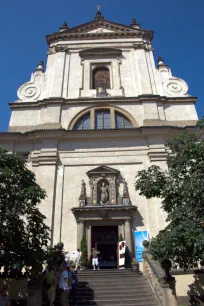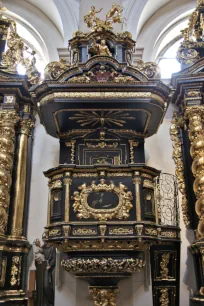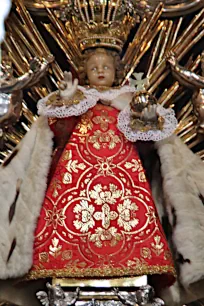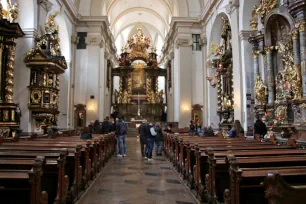The Church of Our Lady Victorious is an early Baroque church that is best known for the so-called “Pražské Jezulátko”, a small statue of an infant Jesus that is displayed at one of its altars.

History
The church was originally called Church of the Holy Trinity. It was built between 1611 and 1613 for German-speaking Lutherans after a design by the Italian architect Giovanni Maria Philippi in an early Baroque style.
In 1620, after the Battle of the White Mountain, which resulted in a defeat of the Bohemian Protestants by the Roman Catholic Habsburgs, the Lutherans were expelled. The church was closed until 1624 when it was acquired by the order of the Carmelites, who dedicated it to Our Lady Victorious in memory of the Catholic victory on the battlefield.
The building as we see it today is the result of a thorough reconstruction that was undertaken between 1636 and 1644, and which included a new front facade and which also altered the orientation of the church. The facade was modeled on the Carmelite church of Santa Maria della Scala in Rome. At the same time, a monastery was added to the south of the church.
In 1784 the monastery was dissolved by order of Emperor Joseph II and the Carmelites were expelled. They returned almost 200 years later, in 1993.



Interior
Pulpit

The church is elaborately decorated throughout, with a combination of black wood and gilded ornaments that contrast with the white walls. This description applies not only to the many altars but also to the ornate pulpit, which features a statue of the Prophet Elias, patron saint of the Carmelite order, at its very top. The prophet is portrayed riding a chariot.
Altars
The church is thematically divided into two halves. The left side contains four altars dedicated to Carmelite saints, while the three altars on the right side are dedicated to the family of Jesus.
At the end of the nave, which divides the two rows of altars, is the main altar. The central painting dates from 1641 and depicts Our Lady praying for victory. Other notable paintings in the church are those by Peter Brandl – one of the most renowned Czech painters in history – on the side altars: The first one is at the altar of Simon Stock (1716) on the left side of the church, the other two are on the right-hand side at the altar of St. Joseph (1720) and at the altar of SS. Joachim and Anne (Mary’s parents, 1720).
Statue of an infant Jesus
But most people come here to see the small statue of the Infant Jesus of Prague. The wood and wax effigy depicts a three-year-old Jesus and is on display at the central altar on the right side of the church. It measures 47 cm in height (18 in.). The infant is flanked by his mother – Our Lady – on the left and his father – St. Joseph – on the right. Above those statues are gilded sculptures depicting the Holy Trinity.
The statue was donated to the Carmelite monastery by Polyxena of Lobkovic whose mother of Spanish heritage had brought it from her home country in 1556. The statue was placed in a small chapel but being credited with miraculous powers it attracted such crowds that people blocked the entrance to the church, so it was moved to its current location in 1741.
The statue is dressed in a robe that is regularly changed depending on the occasion and the liturgical season. Its wardrobe contains about one hundred expensive clothes. An embroidered golden robe is said to have been made by Empress Theresa of Austria herself to thank the effigy for saving the city after French troops retreated during the Siege of Prague in 1742. The only time the small statue does not wear any robes in on Christmas Day.
Museum of the Infant Jesus
To the right of the main altar is a spiral staircase that leads to a small museum which displays a number of historical robes worn by the small statue of the infant Jesus, as well as robes that have been donated by foreign countries.
- Next: Týn Courtyard
- More Sights & Attractions in Prague

